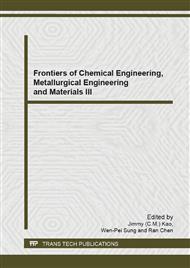p.835
p.839
p.843
p.847
p.851
p.858
p.862
p.868
p.873
Study on Optimization of Cationic Resin Regeneration Conditions
Abstract:
In order to optimize the regeneration conditions of cation exchange resin, the paper based on the actual data of production, the cation exchange resin regeneration condition was optimized by the process of mathematical modeling, which achieved good results. Research showed that reducing regeneration acid feeding time could effectively reduce the consumption. It could reduce the production cost and make enterprises obtain more economic benefits. Calculated and measured were agreed showed that the study and calculation on regeneration of cation bed were accord with actual production, and had practical value for ion regeneration process. Through least square fitting showed that the 80min was the best acid feeding time, acid consumption of unit volume of water was the lowest.
Info:
Periodical:
Pages:
851-857
Citation:
Online since:
August 2014
Authors:
Price:
Сopyright:
© 2014 Trans Tech Publications Ltd. All Rights Reserved
Share:
Citation:


